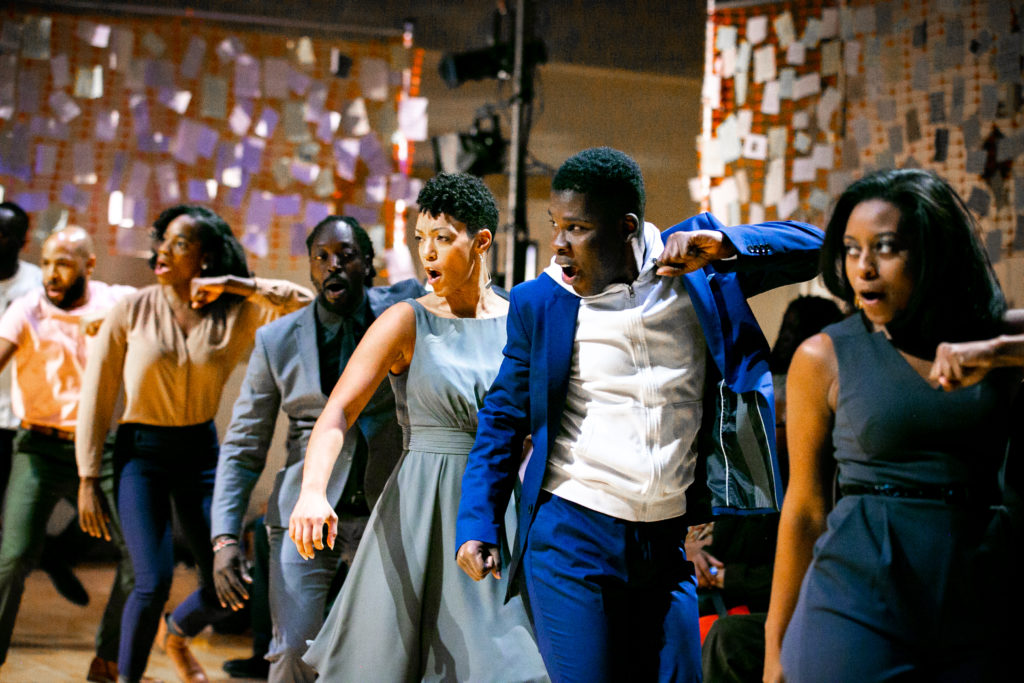
The company of What to Send Up When It Goes Down; Photo by Lauren Miller.
Presented by the American Repertory Theatre
Produced by The Movement Theatre Company
Written by Aleshea Harris
Directed by Whitney White
Presented in collaboration with Hibernian Hall
Ensemble Alana Raquel Bowers (Three), Nemuna Ceesay (Four/Eight), Rachel Christopher (One/Made), Ugo Chukwu (Six/Miss), Kambi Gathesha (Two), Denise Manning (Nine/Song Leader), Javon Q. Minter (Seven), Beau Thom (Five/Man/Driver)
NOV 14 – 16 at Hibernian Hall
184 Dudley Street
Roxbury, MA 02119
NOV 20 – 24 at The Ex (Loeb Drama Center)
64 Brattle Street
Cambridge, MA 02138
Review by Shiyanbade Animashaun
(Roxbury/Cambridge, MA) In its initial moments, What to Send Up When It Goes Down declares itself as a ritual for Black people. Acknowledging the non-Black people in the audience it welcomes all others, with a clear request that all partakers be respectful. Even before it began, I knew the performance would tackle important issues that I resonate with, but the play was surprisingly evocative for the larger audience as well.
Early comers gathered in a room filled with the photos of Black lives cut short by police violence in America. Large, color photos of varied sizes with a simple card stating each person’s name underneath. A small table features a handwritten note from the writer, Aleshea Harris. One audience member remarked that we were ‘surrounded by death’ and ‘metaphorically in an open casket’, and I agree. The tone was immediately sobering as we remembered people of all ages who were taken too young.
The ritual started with interactive exercises. Audience members introduced themselves, made eye contact, and reckoned with the experiences of aggression, racism, and mistreatment by police that some Black people have encountered in their lives. Some wrote love notes to Black people. This continued the work of the ‘metaphorical casket’ by allowing us to see our humanity, through similarities and differences. The audience then took their seats as the performance began, with singing and step dancing.
With parody, various layered scenes create a loose tapestry of emotions. Uncomfortable at times and all too familiar at others, the parody ranges from outright references to coonery and an extreme response to learning a Black man simply walked down the street with his head held high. There is rage, guilt over ones’ privilege, pride in respectability, astonishment at the gall to ‘walk’ as a Black person, and frustration over microaggressions. Each has a specific point to make and seems unrelated to the next.
Then, the actors begin again at a faster pace, invoking a theme of repetition. The repeated performances are transformed this way, some lines cut entirely, while the ones that remain are changed to add depth. Characters stand up earlier, show anger differently, and even transport themselves across the stage in new manners. As such, the new meaning is gleaned while linking reenactments to the originals. The scenes that continue do so with a depth of information borne from the repetition. To me, that signified the numbing constancy of the events depicted, and how it feels to experience it.
Some in the audience teared up at the grief expressed by various characters, as tears streamed down the actors’ faces. In moments of ‘Call and response’, responses grew more pained as the breadth of negativity experienced by Black people in America, throughout history and today, was amplified.

The company of What to Send Up When It Goes Down; Photo by Lauren Miller.
It closed with a celebration as cast members wiped their tears and ended in a supportive circle of jubilant dancing. Those in the audience looked happy to experience their joy. After the piece, Black members were invited to once again stand for an exercise, while other members were greeted outside the hall. I went around reading the handwritten love notes arranged around us. When I finally left, folks from the hall and main venue returned to read them as well.
I can’t say what the other audience members experienced at this point, but our joint closing call was to ‘continue the ritual’. With a poignant set of ‘plays within a play’, it was a moving experience for all who care for humanity. I for one experienced a desire to invite others of all races to remember the lost lives and experience the unapologetic expression of rage and joy that is What to Send Up When It Goes Down.
